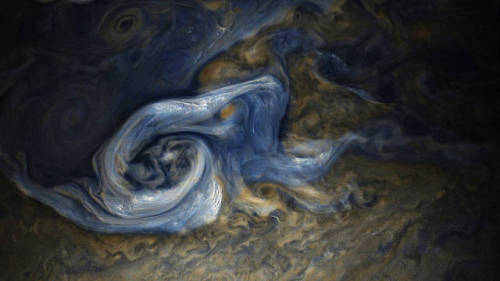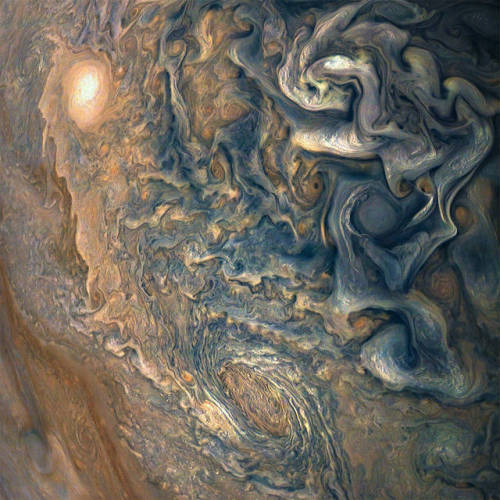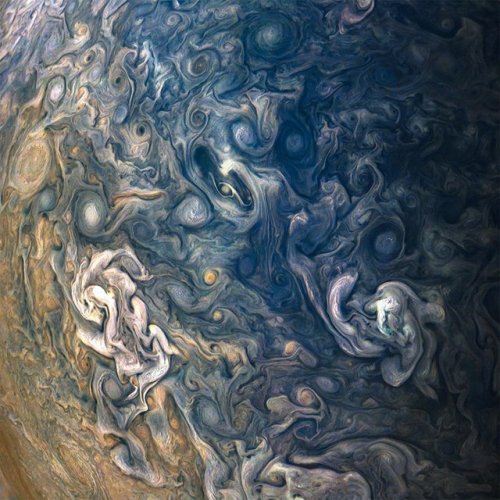(Source)









(Source)
More Posts from Ocrim1967 and Others


The Planets and their respective sizes compared to our Sun.






Swirls of Jupiter
Jupiter is a very stormy, turbulent, violent planet. The planet completes a day (or one complete rotation) within roughly 10 hours, which creates massive winds, producing these swirls, and violent storms. The fast rotation coupled with the fact that the planet is nothing but gas greatly multiplies the Coriolis effect. Earth too has a Coriolis effect, this creates the characteristic hurricane shapes and also contributes to the fact that storms will spin the opposite direction in different hemispheres. Luckily, our rotation is slower - our storms are less frequent and less violent than they would be if our days were shorter.
The above images come from the recent Juno mission by NASA.










This Is How Mastering Dark Matter Could Take Us To The Stars
“Because dark matter is everywhere, we wouldn’t even need to carry it with us as we traversed the Universe. As far as we understand it — and admittedly, we need to understand it a lot farther — dark matter could truly deliver our dream of the ultimate fuel. It’s abundant all throughout our galaxy and beyond; it should have a non-zero annihilation cross-section with itself; and when it does annihilate, it should produce energy with 100% efficiency.
Perhaps, then, most of us have been thinking about experiments seeking to directly detect dark matter all wrong. Yes, we want to know what makes up the Universe, and what the physical properties of its various abundant components truly are. But there’s a science-fiction dream that could come true if nature is kind to us: unlimited, free energy just waiting there for us to harness, no matter where in the galaxy we go.
Mastering dark matter is the endeavor that just might make it so.”
When we talk about our dreams of traveling to the stars, it normally involves a mythical, futuristic form of travel that goes beyond the known laws of physics. Why’s that? Because even if you increase the efficiency of your rocket fuel far beyond the limitations of any chemical-based reaction we know of, you’d still be limited in how far you could go by the mass of your spacecraft and the fuel you were able to take with you on board. You’d still have to accelerate (and decelerate) all the fuel you brought with you, until you ran out. If only there were a 100%-efficient fuel source that was ubiquitous all throughout the galaxy and beyond.
There is: dark matter. Here’s why it’s so important to study, understand, and eventually, fulfill the dream of harnessing it!
I love flowers 💐❤️
























Why 2020 Might Be The Best Geminid Meteor Shower Of All-Time
“As the large parent body of the Geminids, asteroid 3200 Phaethon, continues on its tight orbit around the Sun, it will continue to expel matter and be torn apart, bit by tiny bit. The asteroid is about the size of the one that struck Earth 65 million years ago, causing our last great mass extinction. But instead of colliding with us all at once, this ~6 km wide asteroid is slowly dissipating in the presence of the Sun, creating tails of matter and ions but also an ever-thickening debris stream.
With each mid-December that rolls past, Earth slams through that debris stream, creating a show that gets progressively more spectacular with each set of orbits that regularly tick by. Over the past 15 years, the Geminids have regularly been one of the two best displays of meteor showers on Earth, and it’s eminently possible that 2020 will set a new record. The Moon, the Earth, and all of the other predictable conditions are just right for a spectacular show. If the clouds cooperate on December 13 and 14, treat yourself to the greatest natural show of the year. With all that 2020 has brought us, we can all use a cosmic treat like this one.”
Can everyone just have a good thing to enjoy? Can we all just have something nice that we don’t have to fight over? Well, nature might deliver what humanity has been unable to bring us for 2020: a natural show that can’t be stopped by anything, except for clouds.
Get your Geminid fix today, and then look up on December 13/14 to fully enjoy the show!
The Smoke From a (Not-so) Distant Fire
Flying directly through thick plumes of smoke may seem more harrowing than exciting. But for members of the CAMP2Ex science team, the chance to fly a P-3 Orion straight through clouds of smoke billowing off fires from Borneo this week was too good an opportunity to pass up.

CAMP2Ex stands for the Cloud, Aerosol and Monsoon Processes in the Philippines Experiment. The 2, by the way, is silent.

It’s a field campaign based out of Clark in the Philippines, flying our P-3, a Learjet and collaborating with researchers on the research vessel Sally Ride to understand how tiny particles in the atmosphere affect cloud formations and monsoon season.

The tiny aerosol particles we’re looking at don’t just come from smoke. Aerosol particles also come from pollution, billowing dust and sea salt from the ocean. They can have an outsized effect on weather and climate, seeding clouds that bring rain and altering how the atmosphere absorbs the Sun’s heat.

The smoke we were flying Monday came from peat fires, burning through the soil. That’s pretty unusual — the last time Borneo had these kind of fires was in 2015, so it was a rare opportunity to sample the chemistry of the smoke and find out what’s mixing with the air.

The planes are loaded with instruments to learn more about aerosol particles and the makeup of clouds, like this high-speed camera that captures images of the particles in flight.

One instrument on the plane collects droplets of cloud water as the plane flies through them, and on the ground, we test how acidic and what kind of particles form the cloud drops.

All of these measurements are tools in improving our understanding of the interaction between particles in the air and clouds, rainfall and precipitation in the Pacific Ocean.

Learn more about the CAMP2Ex field campaign, here!
Make sure to follow us on Tumblr for your regular dose of space: http://nasa.tumblr.com
What is a Wormhole?
Wormholes were first theorized in 1916, though that wasn’t what they were called at the time. While reviewing another physicist’s solution to the equations in Albert Einstein’s theory of general relativity, Austrian physicist Ludwig Flamm realized another solution was possible. He described a “white hole,” a theoretical time reversal of a black hole. Entrances to both black and white holes could be connected by a space-time conduit.

In 1935, Einstein and physicist Nathan Rosen used the theory of general relativity to elaborate on the idea, proposing the existence of “bridges” through space-time. These bridges connect two different points in space-time, theoretically creating a shortcut that could reduce travel time and distance. The shortcuts came to be called Einstein-Rosen bridges, or wormholes.

Certain solutions of general relativity allow for the existence of wormholes where the mouth of each is a black hole. However, a naturally occurring black hole, formed by the collapse of a dying star, does not by itself create a wormhole.
Wormholes are consistent with the general theory of relativity, but whether wormholes actually exist remains to be seen.

A wormhole could connect extremely long distances such as a billion light years or more, short distances such as a few meters, different universes, or different points in time
For a simplified notion of a wormhole, space can be visualized as a two-dimensional (2D) surface. In this case, a wormhole would appear as a hole in that surface, lead into a 3D tube (the inside surface of a cylinder), then re-emerge at another location on the 2D surface with a hole similar to the entrance. An actual wormhole would be analogous to this, but with the spatial dimensions raised by one. For example, instead of circular holes on a 2D plane, the entry and exit points could be visualized as spheres in 3D space.

Science fiction is filled with tales of traveling through wormholes. But the reality of such travel is more complicated, and not just because we’ve yet to spot one.

The first problem is size. Primordial wormholes are predicted to exist on microscopic levels, about 10–33 centimeters. However, as the universe expands, it is possible that some may have been stretched to larger sizes.
Another problem comes from stability. The predicted Einstein-Rosen wormholes would be useless for travel because they collapse quickly.

“You would need some very exotic type of matter in order to stabilize a wormhole,” said Hsu, “and it’s not clear whether such matter exists in the universe.”
But more recent research found that a wormhole containing “exotic” matter could stay open and unchanging for longer periods of time.

Exotic matter, which should not be confused with dark matter or antimatter, contains negative energy density and a large negative pressure. Such matter has only been seen in the behavior of certain vacuum states as part of quantum field theory.
If a wormhole contained sufficient exotic matter, whether naturally occurring or artificially added, it could theoretically be used as a method of sending information or travelers through space. Unfortunately, human journeys through the space tunnels may be challenging.

Wormholes may not only connect two separate regions within the universe, they could also connect two different universes. Similarly, some scientists have conjectured that if one mouth of a wormhole is moved in a specific manner, it could allow for time travel.

Although adding exotic matter to a wormhole might stabilize it to the point that human passengers could travel safely through it, there is still the possibility that the addition of “regular” matter would be sufficient to destabilize the portal.
Today’s technology is insufficient to enlarge or stabilize wormholes, even if they could be found. However, scientists continue to explore the concept as a method of space travel with the hope that technology will eventually be able to utilize them.
source
source
images: x, x, x, x, x, x, x, x, x








(Source)
-
 bonjourlasodomie liked this · 1 year ago
bonjourlasodomie liked this · 1 year ago -
 biiitchpork liked this · 1 year ago
biiitchpork liked this · 1 year ago -
 petals4sir reblogged this · 2 years ago
petals4sir reblogged this · 2 years ago -
 v3-petals1021 liked this · 2 years ago
v3-petals1021 liked this · 2 years ago -
 towman55 liked this · 2 years ago
towman55 liked this · 2 years ago -
 sheyla88-blog reblogged this · 3 years ago
sheyla88-blog reblogged this · 3 years ago -
 dear-jaimie liked this · 4 years ago
dear-jaimie liked this · 4 years ago -
 thesilverfoxsblog liked this · 4 years ago
thesilverfoxsblog liked this · 4 years ago -
 mi-vida-secreta20 reblogged this · 4 years ago
mi-vida-secreta20 reblogged this · 4 years ago -
 warriorbuffytheslayer liked this · 4 years ago
warriorbuffytheslayer liked this · 4 years ago -
 stillenvy liked this · 4 years ago
stillenvy liked this · 4 years ago